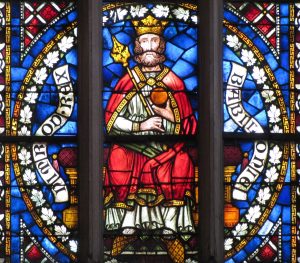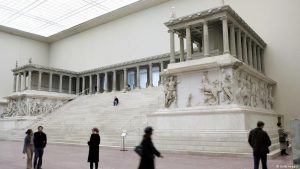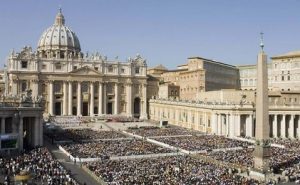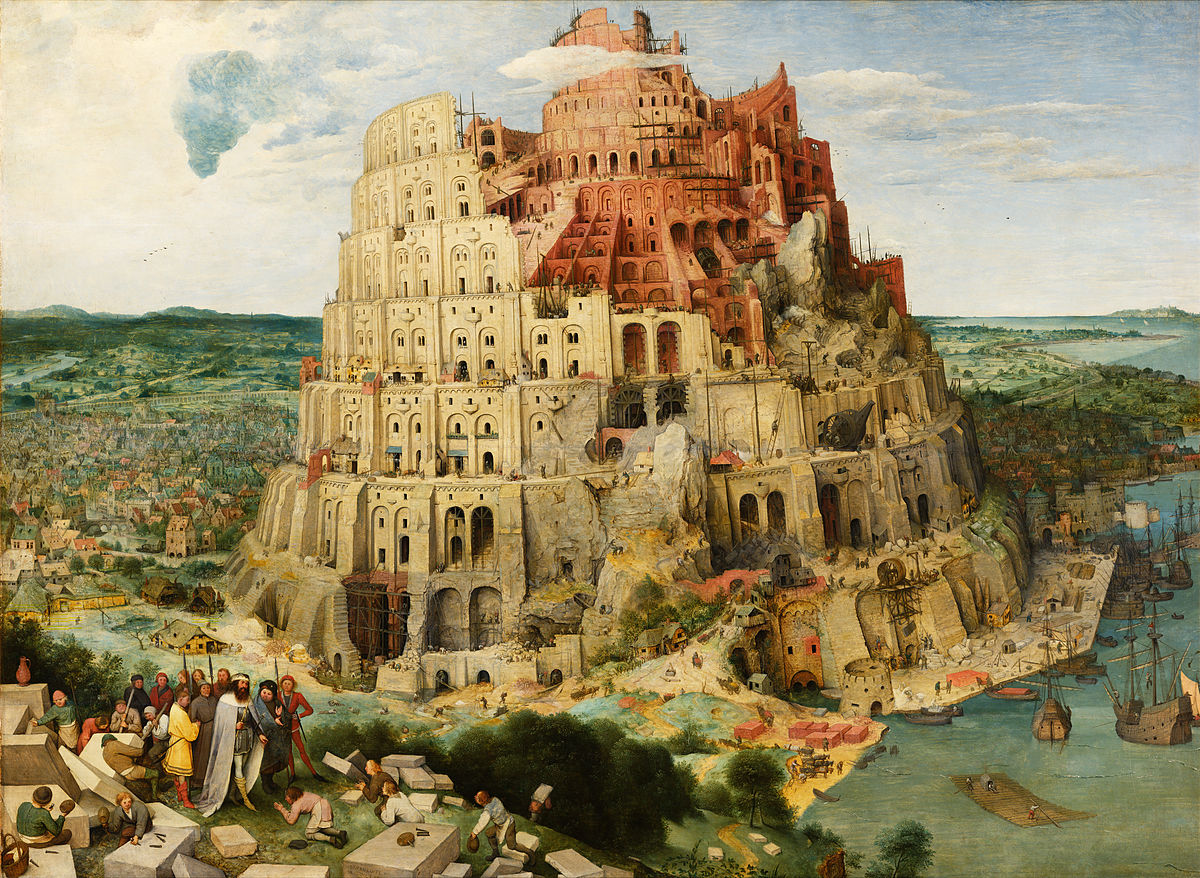I don't have much interest in mythology. Stories about gods and goddesses were wasted on me, and at high school you didn't have to worry about them. But this week I came across a story [1] from the well-known Dr. HA Ironside on the Origin of the Pagan Religions. He broadly outlines the history of idolatry from Nimrod, also mentioned in the Bible, to the Roman church of our time.
Als achtergrond bij het thema van deze site lijkt het me nuttig hiervan kennis te nemen.
I suspect it was a speech he gave somewhere. I myself have put some headings in between, added bible texts and added footnotes.
Nimrod
Als we aan de hand van de Schrift teruggaan naar het begin van de geschiedenis, zien we dat de stichter van Bab-el, of Babylon, Nimrod was, van wiens onheilige praktijken we lezen in het 10e hoofdstuk van Genesis. Hij was de aarts-afvallige van het tijdperk van de aartsvaders. Hij wordt getypeerd als een “machtige jager voor de Heer”; “een jager van de zielen van mensen”, volgens de rabbijnen. Hij verliet de aanwezigheid van de Heer, en probeert op goddeloze wijze een menigte mensen achter zich te verzamelen. In weerwil van het uitdrukkelijke gebod van God om zich over het aardoppervlak te verspreiden, overtuigde hij zijn medestanders en volgelingen ervan om samen te werken bij “het bouwen van een stad en een toren die tot de hemel zouden reiken” (Genesis 11:4).
Sommigen van ons hebben in onze kindertijd geleerd dat ze een toren bouwden om naar de hemel te kunnen ontsnappen als er weer een nieuwe overstroming zou komen. Maar eigenlijk gaat het om een bekende en hoge toren, die door allen gezien kon worden als een tempel voor degenen die niet in gehoorzaamheid aan het woord van de Heer wandelden. Met dezelfde onbeschaamdheid als moderne afvalligen, noemden ze hun stad en toren Bab-El, dat is ‘de poort van God’. Maar door het goddelijke oordeel werd het al snel veranderd in Babel, dat is ‘verwarring’. Het droeg vanaf het begin het stempel van namaak, want er wordt ons verteld: “En de kleiblokken dienden hun tot steen en het asfalt diende hun tot leem” (Genesis 11:3). Sindsdien is Babylon door alle eeuwen heen gekarakteriseerd door imitatie van dat wat echt en waar is.

Nimrod, of Nimroud-bar-Cush, zoals hij op de (archeologische) monumenten wordt genoemd, was een kleinzoon van Cham, de onwaardige zoon van Noach, wiens karakter blijkt wanneer hij de schaamte van zijn vader ontdekt (Genesis 9:21,22). We weten dat Noach door de zondvloed heen de openbaring van de ware God had gedragen, want hij was een prediker van gerechtigheid en bij meerdere gelegenheden laat hij zien dat hij de profetische gave had. Cham daarentegen lijkt te gemakkelijk beïnvloed te zijn door de afvalligheid die leidde tot de vloed, want hij vertoont geen tekenen van zelfoordeel, maar juist het tegenovergestelde. Zijn naam, zoals gespeld op Egyptische monumenten, is Khem, en dit komt overeen met het letterlijke geluid van het Hebreeuwse woord dat Cham in onze bijbels weergeeft. Het betekent “donker”, “verduisterd”, of meer letterlijk, “door de zon verbrand”. De naam geeft de toestand van de ziel van de man aan. Want wat is een zongebruinde persoon? Iemand die verduisterd wordt door licht van de hemel. Cham had bijzondere genade ontvangen. Hij werd gered van de zondvloed vanwege het geloof van zijn vader, maar hij misbruikte zijn voorrechten en “veranderde de genade van God in losbandigheid” (Judas 1:4). Hij werd eigenlijk verduisterd door de brandende lichtstralen die God op zijn ziel liet schijnen. Zo werd zijn geweten als met een heet strijkijzer dichtgeschroeid, en hij werd de grondlegger van een ras dat afvallig was van de levende God en de weg van de afgoderij bewandelde. Ze aanbaden het schepsel meer dan de Schepper.
Hardening - the light that darkens
We weten iets van wat dit betekent. We spreken vandaag over mensen die, zoals we zeggen, hun hart verhard hebben voor het evangelie. Ook zij zijn verduisterd door het licht, en zijn vaak de leiders in afvalligheid: “Als het licht dat in u is wordt verduisterd, hoe groot is de duisternis” (Mattheus 6:23b). Er zijn velen in de wereld die met tranen in hun ogen luisteren naar de geschiedenis van de weergaloze genade van God zoals die is geopenbaard in het kruis van Christus, maar het niet persoonlijk op zichzelf betrekken. Ze zijn verhard in hun zonden en hun dichtgeschroeide geweten voelt niet langer de adem van de Geest. Het is gevaarlijk om met licht uit de hemel te spotten.
Maar om verder te gaan met ons thema, werd Cham ‘verduisterd door het licht’. We kennen zijn falen en zonde. Maar toen Noach zich hersteld had en wist wat zijn zoon hem had aangedaan, sprak hij, door de geest van profetie, een vloek uit over Kanaän en niet over Cham (Genesis 9:18,25-27). Verwonder je je daarover? Dat deed ik ook, totdat ik zag dat God al een zegen had uitgesproken over alle drie de zonen van Noach – Sem, Cham en Jafeth (Genesis 9:1). Noach slaat dus zijn onwaardige zoon over en spreekt een vloek uit over Kanaän, waarvan we goed kunnen geloven dat hij, zoals we zeggen, “een aartje naar zijn vaartje”, had. Cham verwekte een zoon genaamd Cush, “de zwarte”, en hij werd de vader van Nimrod, de afvallige leider van zijn generatie.
Semiramis - the woman and her seed
Ancient traditions now help us and tell us that the wife of Nimrod-bar-Cush was the infamous Semiramis, the First[2]. She is known as the founder of the Babylonian mysteries and the first high priestess of idolatry. Thus Babylon became the source of idolatry and the mother of all the Gentiles and every pagan system in the world. The mystery religion that arose there spread in various forms all over the earth, and as we shall see, it is among us today. This religion is identical with the "mystery of lawlessness" (2 Thessalonians 2:7) that was so potent in Paul's day. It will be at its peak when the Holy Spirit is taken from the earth and the Babylon of the Apocalypse holds sway.
Building on the original promise of the woman's seed to come, Semiramis bore a son who - she said - was miraculously conceived, and when she presented him to the people, he was hailed as the promised deliverer. This was Tammuz, against whose worship Ezekiel protested in the days of exile (Ezekiel 8:14). Thus was introduced the mystery of the mother and child, a form of idolatry older than any other. The rituals of this worship were secret. Only the initiated were allowed to know the mysteries. It was Satan's attempt to deceive mankind with an imitation of the truth of God, lest they (re)know the true seed of the woman when He came in the fullness of time. Of this, Justin the Martyr explains[3] a clear testimony.

Mother and child - the queen of heaven
From Babylon, this mystery religion spread to all the surrounding nations as the years went on and the world was populated by the descendants of Noah. Everywhere the symbols were the same, and everywhere the cult of the mother and child became the popular system. Their worship was celebrated with the most disgusting and immoral practices. The image of the Queen of Heaven with the baby in her arms was everywhere, although the names could vary according to the languages. It became the mystery religion of Phoenicia and was spread to the ends of the earth by the Phoenicians. Ashtoreth and Tammuz, the mother and child of these strong adventurers (the Phoenicians), became Isis and Horus in Egypt, Aphrodite and Eros in Greece, Venus and Cupid in Italy, and in more distant places they bore still other names. Within 1000 years the religion of Babylon had become the religion of the world which had rejected divine revelation.
Tammuz
Linked to the central mystery were countless smaller mysteries whose hidden meaning was known only to the initiated, but whose external forms were practiced by all people. These included the doctrine of purgative purification after death, salvation through numerous sacraments (such as priestly absolution), sprinkling with holy water, offering round cakes to the queen of heaven (as mentioned in the book of Jeremiah - 7:18; 44:17-25), dedication of virgins to the gods (which was literally sanctified prostitution), bewailing Tammuz (see also Ezekiel 8:14) during a period of 40 days preceding the great feast of Istar[4] (who was said to have conceived her son from the dead). It was learned that Tammuz was killed by a wild boar and then brought back to life. An evergreen tree became the symbol of his birth and erected at the time of the winter solstice. Furthermore, the egg was sacred to him because it depicted the mystery of his resurrection.
Het teken van het kruis was heilig voor Tammuz, als symbool van het leven gevende principe en als eerste letter van zijn naam. Het is aangebracht op enorme aantallen van de oudste altaren en tempels, en is niet, zoals velen veronderstellen, ontstaan ten tijde van het christendom. Uit deze mysteriegodsdienst werd de aartsvader Abraham afgescheiden door goddelijke roeping. Met deze zelfde boze eredienst had het volk dat uit hem voortkwam voortdurend ruzie, totdat het onder Izebel, een Fenicische prinses, ten tijde van Achab werd geënt op wat er nog over was van de godsdienst van Israël in het noordelijke koninkrijk. Uiteindelijk was het de oorzaak van hun ballingschap. Juda was erdoor bezoedeld, want Baäl-aanbidding was slechts de Kanaänitische vorm van Babylonische mysteriën, en alleen door in ballingschap naar Babylon zelf te worden gestuurd, werd Juda genezen van haar voorliefde voor afgoderij. Baäl was de Zonnegod, de Levengevende, identiek met Tammuz.
The mystery of lawlessness
When Christ came into this world, the "mystery of lawlessness" was dominant everywhere except where the truth of God as revealed in the Old Testament was known. So when the early Christians began the great task of taking the gospel to the ends of the earth, they were confronted with this system everywhere, in one form or another. For though Babylon as a city had long been but a mystery, her mysteries had not died with her. When the city and the temples were destroyed, the high priest fled with a company of initiates and their sacred objects and images to Pergamos[5][6], where the symbol of the serpent was established as the emblem of the hidden wisdom. From there they crossed the sea and emigrated to Italy, where they settled on the Etruscan plain.

To Rome
There the ancient cult was propagated under the name of Etruscan Mysteries, and Rome eventually became the headquarters of Babylonian life. The chief priests wore fish-headed miters in honor of Dagon, the fish god, the Lord of life. It is another form of the Tammuz mystery as developed among Israel's ancient enemies, the Philistines. The high priest, when he settled in Rome, was given the title Pontifex Maximus, and this title was depicted on his mitre. When Julius Caesar (who was an initiate like all young Romans from good families) had become the head of the empire, he was elected Pontifex Maximus. This title was henceforth held by all Roman emperors down to Constantine the Great, who was both head of the church and high priest to the pagans at the same time.[7], for whom he, like his idolatrous predecessors, wears the fisherman's ring[8].
During the early centuries of the Church's history, “the mystery of lawlessness” (2 Thessalonians 2:7) had astonishing effects. Babylonian practices and teachings were so absorbed by what called themselves "Church of Christ" that the truth of the Scriptures was completely obscured on many points, while idolatrous practices were forced upon the people as Christian sacraments and pagan philosophies took the place of gospel teaching. Thus was born that amazing system that dominated Europe for a thousand years and made commodities of “bodies and souls of men” (Revelation 18:13), bringing a measure of liberation until the great Reformation of the 16th century.

Some remarks as caption.
- This treatise by HA Ironside shows a clear line from the origin of idolatry in the time of Nimrod to the present day in the church of Rome. How sad it is then to see that the Reformation is less and less over and Protestantism will also show the characteristics of Babylon.
- There are indications that other religions such as Islam and Hinduism also originated from Babylon. If all religions have the same source and core, it is easy to imagine that in our time they work together as the one world religion.
[1] Translation of the article on http://www.biblelineministries.org/articles/basearch.php3?action=full&mainkey=BABYLONIAN+RELIGION+%28By+Harry+A.+Ironside%29
[2] https://nl.wikipedia.org/wiki/Semiramis_(koningin);
[3] https://nl.wikipedia.org/wiki/Justinus_de_Martelaar
[4] https://nl.wikipedia.org/wiki/Isjtar_(godin)
[5] The Istar gate from Pergamus was recreated in the last century in the Pergamus museum in Berlin. See https://nl.wikipedia.org/wiki/Pergamonmuseum.
[6] See also Revelation 2:12-17, where it is said that in Pergamos is the 'throne of Satan' and that Satan dwells there.
[7] https://nl.wikipedia.org/wiki/Dagan
[8] https://nl.wikipedia.org/wiki/Vissersring



